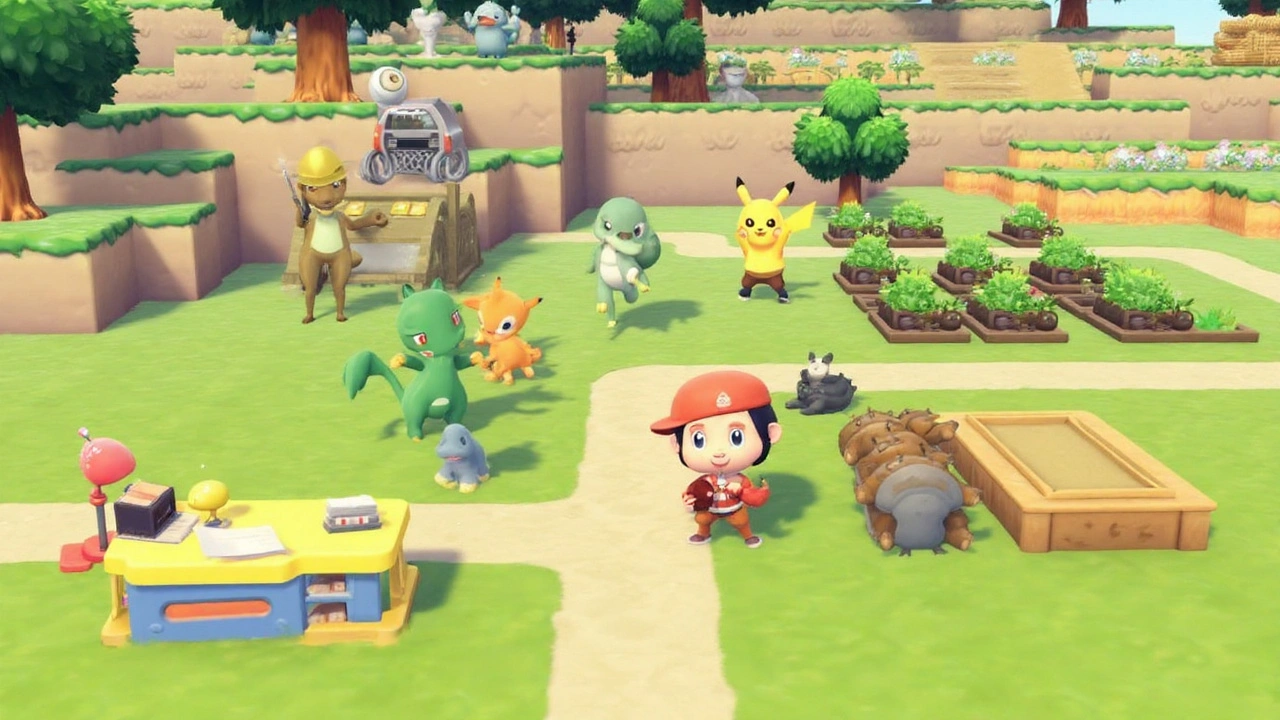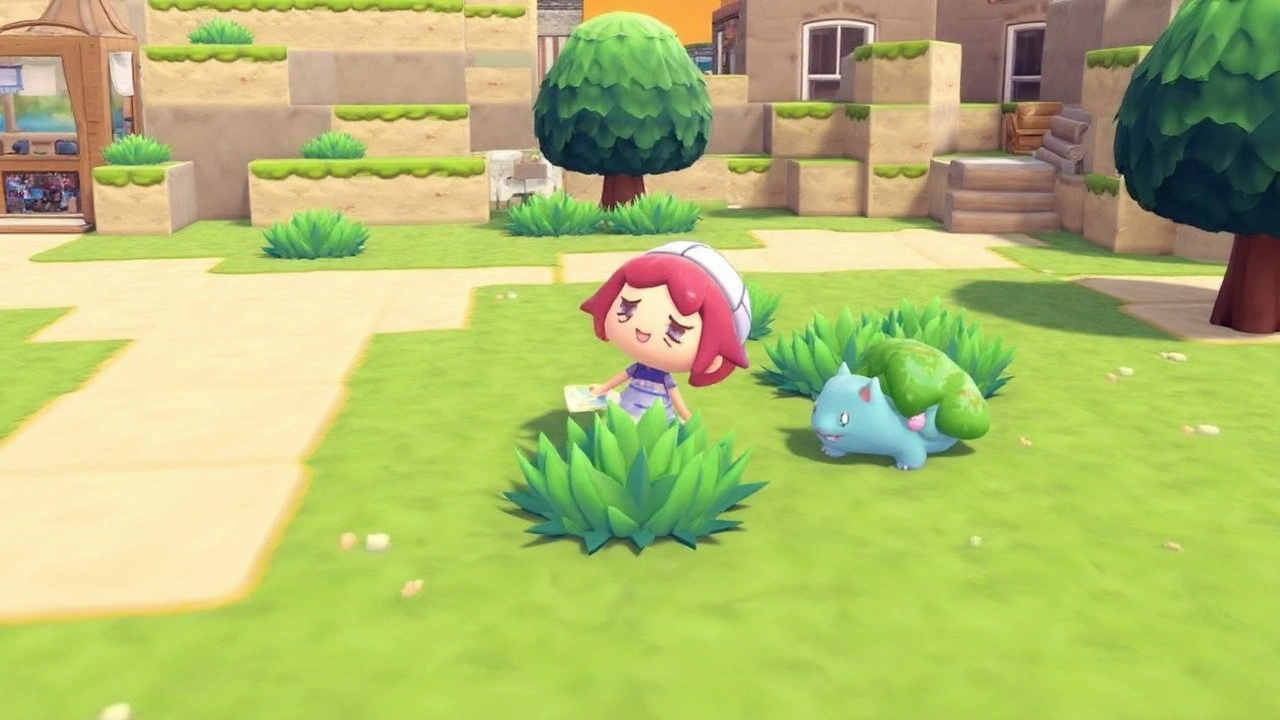Ditto becomes a world builder in Nintendo’s life sim experiment
Nintendo has announced Pokemon Pokopia, a spin-off that swaps gym badges and battles for crafting, farming, and slow-build creativity. Revealed during the September 12, 2025 Nintendo Direct, it is the series’ first true life simulation game. You play as a Ditto that has taken human form, then use learned Pokemon abilities to transform empty terrain into a living community where Pokemon wander, settle, and help the place grow.
The hook is simple and smart: your Ditto can learn functional abilities from Pokemon it meets, then apply them to building and upkeep. Learn Leafage from Bulbasaur and you can blanket bare earth with fresh greenery. Borrow Water Gun from Squirtle and you can irrigate fields and keep ponds topped up. Hitmonchan teaches you how to punch and reshape terrain, while lessons from Timburr unlock carpentry and construction. These aren’t just party tricks; they fold directly into the core loop of gathering, crafting, and designing.
That loop leans into familiar life sim rhythms with a Pokemon twist. You collect wood, stone, and other materials; craft furniture; raise crops; and build homes for yourself and visiting Pokemon. As the settlement gets prettier and more functional, more species show up, hang around, and add personality to the place. The starting zone is intentionally sparse, inviting you to turn it into a welcoming habitat. The trailer showcases cozy interiors, harvested plots, and outdoor paths dotted with roaming Pokemon that react to what you build.
Game Freak is developing the project in collaboration with Koei Tecmo, a partner with history in the franchise. The last major crossover between the two companies led to Pokemon Conquest in 2012, a tactics spin-off that found a loyal following. Here, Koei Tecmo’s experience with systems-heavy simulations pairs with Game Freak’s world design to support a sandbox that changes over time.
To make daily play feel alive, Pokopia runs on dynamic weather and a day-night cycle. That means rain for crops, morning and evening light for mood, and likely routines that shift depending on the time. The pitch emphasizes a go-at-your-own-pace style. There’s no rush to maximize output; the game is designed so you can tinker for 10 minutes or settle in for an hour, shaping the world one small decision at a time.
Nintendo is positioning Pokopia as a complement to, not a replacement for, mainline Pokemon adventures. By letting Ditto copy practical abilities, the game makes the catalog of moves double as tools. It’s a neat inversion of the franchise’s usual battle-first design. The result borrows some of the best ideas from genre leaders — Minecraft’s freeform building, Animal Crossing’s homey rhythm — but filters them through Pokemon logic. You are still assembling a team of helpers, only now the help is a move that waters tomatoes or a punch that levels a hillside for a town square.
- Platform: Nintendo Switch 2
- Release window: 2026
- Digital preorders: Open November 12, 2025 on Nintendo eShop and My Nintendo Store
- Developer: Game Freak with Koei Tecmo
- Core idea: Learn Pokemon abilities to build, farm, craft, and terraform
- Systems: Dynamic weather and day-night cycle
- Tone: Relaxed, player-paced, sandbox
Art direction lands in that bright, inviting lane the series is known for. Environments are colorful and readable; materials like wood, stone, and soil are easy to read at a glance, which matters when you are shaping spaces. Interiors lean cozy rather than ornate, with crafted pieces that feel hand-built instead of factory-perfect. The aim is clarity and charm over photorealism, closer to the warmth of life sims than the sharpness of action RPGs.
Under the hood, the ability system does a lot of heavy lifting. Because moves have clear verbs — water, grow, punch, build — they map naturally to chores. That keeps the to-do list from feeling like busywork. When you irrigate with Water Gun, you are using a familiar move in a new context, which adds a tiny hit of delight. It also opens up a steady path for progression: encounter more species, expand your toolkit, tackle bigger projects. Terraform a riverbank today, scaffold a cliffside orchard next week.
The structure looks flexible enough to support different play styles. If you like agriculture loops, you can till, plant, and manage irrigation. If you prefer architecture, pulling in Timburr’s know-how turns you into a builder, with blueprints and material recipes to chase. If you are a wanderer, the changing weather and time of day provide reasons to explore and gather. The game doesn’t force a single optimal path, which is key for staying power in a life sim.
There’s also an ecosystem angle that suits Pokemon. Watering too much or too little might nudge certain species to appear or move on. Leafage could help rewild a barren patch, making it hospitable for grass types. Punching through rock to reroute a stream might attract water types but discourage others. Nintendo has not detailed these systems in depth, but the premise invites subtle cause-and-effect that rewards observation.
As with any life sim, momentum over months will depend on goals and gentle nudges. Expect seasonal tasks tied to weather patterns and time-of-day moments that change the feel of your space. The team can rotate in building sets, new crops, or visiting Pokemon to keep players checking in. The format is a natural fit for periodic updates, though no post-launch plan has been announced.
Timing matters too. Launching on Switch 2 in 2026 gives Pokopia a clean slate to leverage newer hardware while the platform is still fresh. The preorder date — November 12, 2025 — sets a clear marker for when Nintendo will likely share more detail. Expect deeper dives on crafting trees, ability interactions, and how settlements scale from a campsite to a full town.

Why this spin-off could broaden the Pokemon audience
Pokemon spin-offs tend to succeed when they twist a core idea into a new genre without losing the series’ heart. Snap put the focus on observation. Mystery Dungeon leaned into character bonds and exploration. Pokopia is the first to reframe Pokemon moves as tools for building a shared place. That makes it instantly legible to families and players who skipped battle-heavy entries but love the comfort of tending a space.
The comparison points are obvious, but the differences matter. Animal Crossing is built on routine and social charm. Minecraft is a blank canvas with survival and creativity at its core. Pokopia has a cast of creatures that already come with fan affection and recognizable abilities, which cuts friction. When you see a Squirtle help your crops, that’s not just a mechanic — it’s a character you know contributing to the vibe you’re building.
For Nintendo, it is a strategic move to seed evergreen games early in a console cycle. Life sims typically have long tails; players dip in and out for years. If Pokopia lands, it can sit alongside tentpoles as a steady draw, especially if it supports gentle community features. Nintendo has not announced online sharing or co-op, and it has not discussed Amiibo or Pokemon Home support. Those are open questions worth watching.
What we still don’t know is just as interesting. We don’t have a confirmed list of regions or biomes, nor a sense of how many abilities can be learned at once. It is unclear whether learned moves upgrade over time, whether there is a central narrative arc, or how visiting Pokemon decide to settle. Performance targets on Switch 2, save compatibility across profiles, and any parental controls tailored to younger players also remain to be detailed.
On the business side, Nintendo has not outlined editions, bonuses, or any monetization beyond the base game. The genre tends to resist aggressive add-ons because the appeal is the slow, personal craft of tinkering. Given the family-friendly positioning and the studio mix behind it, the expectation is a clean, up-front package, but we will have to wait for specifics.
The early footage sets a clear tone: relaxed, tactile, and quietly playful. You see a Ditto-turned-person carry planks, place beams, water a row of sprouts, then step back as a couple of Pokemon wander through the new space. It is less about beating a checklist and more about watching a place feel lived-in. If Nintendo can keep that loop satisfying over weeks and months, Pokopia could become the series’ most inviting spin-off in years.
For now, the basics are locked: a 2026 release window, exclusive to Switch 2, with digital preorders opening November 12, 2025. Between now and then, expect Nintendo to answer the big questions about progression, systems depth, and how far the ability toolkit can stretch. The premise is strong; the rest will come down to how well the team turns familiar Pokemon moves into satisfying, everyday tools for making a world your own.





Write a comment